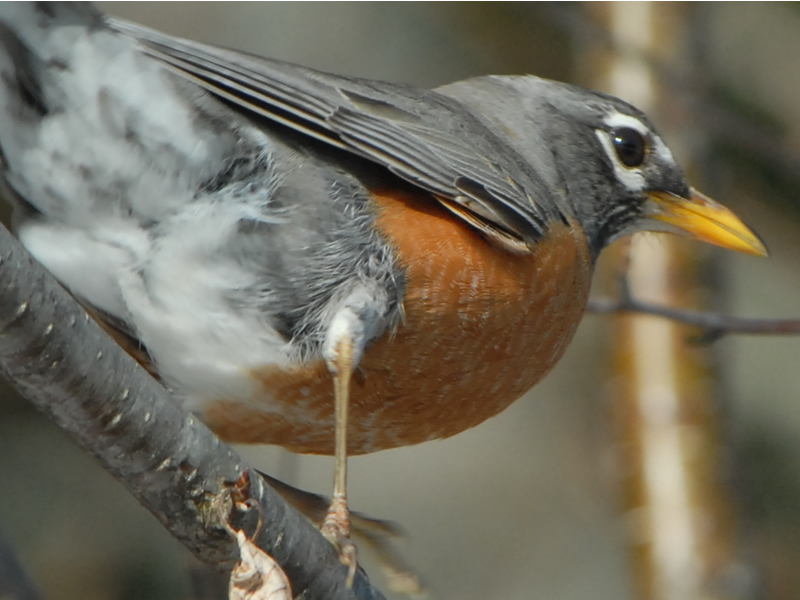What is the
typical traveling day of a migrating robin? Let's go along for the ride:
In spring, robins feel restless, ready to migrate. Their whole body is
urging them to establish a territory, mate, and raise babies--but they
can't start any of these until they arrive on their breeding grounds.
Robins are very unusual migrants in that they can migrate by day or by
night. In autumn, many huge robin flights take place in daylight, but
in spring, they often fly by night. Why do you think there is a difference
between seasons? Might it have something to do with their different food
choices in spring and fall?
Fuel for Migration: Hunting for
Food
When cold
weather holds them back, robins spend their days searching for food and
eating as much as they possibly can. The berries and fruits still sticking
to trees after the long winter are the ones that taste the worst--birds
eat their favorite berries first of all, just like people eat our favorite
Halloween candy first, so the last ones sitting around are just about
always the worst kinds. And for robins, any last berries hanging around
are even starting to get a little rancid, so they will only eat them now
only if they really can't find anything better. Fortunately, right when
they need it most, the ground starts thawing, and suddenly big fat succulent
earthworms are ripe for the picking!
Robins eat a lot of food, especially during migration. Their bodies must
get as fat as possible to allow them to fly long distances without stopping.
This would be unhealthy for us humans, because fat tissue might damage
our hearts or block our arteries and veins, but bird bodies are made to
store fat very efficiently in a healthy way. When a robin wakes up at
first light, he (and the first migrating robins are ALWAYS males) is hungry!
He immediately starts searching the ground for any worms or insects he
can find. Yummmmm! Cold breakfast!
When his stomach gets full, he starts feeling restless. Migrating robins
usually stay in flocks, which is one good way to tell if a robin you're
seeing is a migrant headed farther north or one that is going to stay.
Communication, Robin Style
You can learn
alot by listening to them too: If one of the robins spots a person or
other mild danger, if makes its "whinny" call, and the other
robins check it out. If the danger gets closer, they take off. If a hawk
or shrike approaches from overhead, the first one to spot it opens its
beak wide and makes a very high-pitched "Seeee" call, and all
the robins instantly crouch low in place and freeze. They can wait for
many minutes without moving. Once the danger is past, they all go back
to eating. All the robins in the flock are antsy to move on, and suddenly
they do--the whole flock just picks up and leaves! In the air or taking
off, they often give their "Zeeeeup!" call, a contact call for
migrating.
The Final Leg of Migration
If the weather
is warm and migrating conditions are right, the flock will head in a northerly
direction, but if they suddenly spot a promising looking field they'll
drop down for a break and a snack. If the weather is too cold for migrating,
they'll search for likely fields where they can find food in more of a
circle, all around the area they're in. Sometimes, if the weather turns
very cold, they'll actually head south again in their search for food.
All day long they eat and move about restlessly. When night comes, they
sleep. Until, one night, when they have lots of food in their stomachs,
lots of fat on their bodies, and the weather has been just warm enough,
suddenly they REALLY take off!
Robin daytime movements are pretty low to the ground. But at night, when
they have trouble seeing shadows, they rise higher to avoid bonking into
things. They may fly as high as a mile up in the air, though usually they
fly lower than that.
When each robin finally arrives on his territory, he bursts into song!
It sounds as if he's singing from sheer joy to be home, but as humans,
we really can't be sure how birds really feel. We do know that his song
tells other robins to STAY OUT! And when migrating robins hear a territorial
robin's song, it makes them more restless to press north to find their
own territories.
 |
 |
 |
 |
 |
Migrating Robins Passing through Vermont Photos by Elizabeth Howard |


